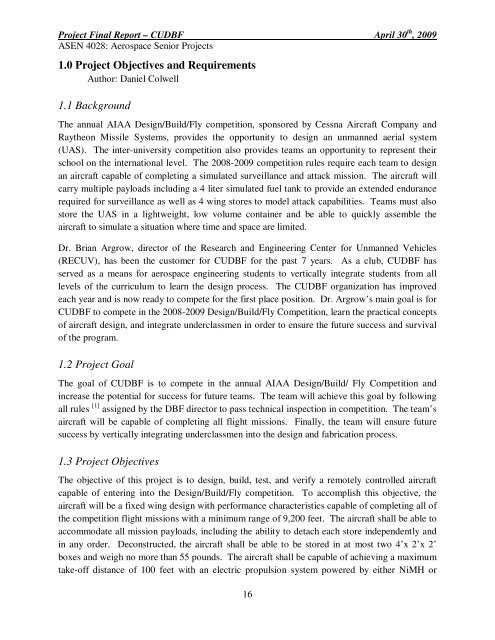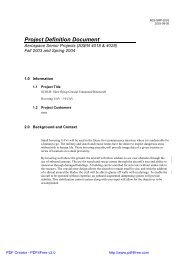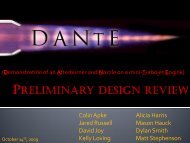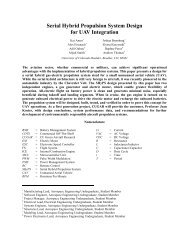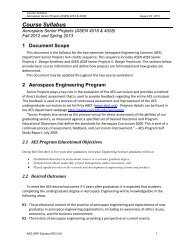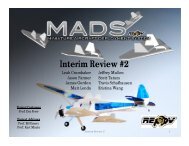PFR - Aerospace Engineering Sciences Senior Design Projects ...
PFR - Aerospace Engineering Sciences Senior Design Projects ...
PFR - Aerospace Engineering Sciences Senior Design Projects ...
Create successful ePaper yourself
Turn your PDF publications into a flip-book with our unique Google optimized e-Paper software.
Project Final Report – CUDBF April 30 th , 2009<br />
ASEN 4028: <strong>Aerospace</strong> <strong>Senior</strong> <strong>Projects</strong><br />
1.0 Project Objectives and Requirements<br />
Author: Daniel Colwell<br />
1.1 Background<br />
The annual AIAA <strong>Design</strong>/Build/Fly competition, sponsored by Cessna Aircraft Company and<br />
Raytheon Missile Systems, provides the opportunity to design an unmanned aerial system<br />
(UAS). The inter-university competition also provides teams an opportunity to represent their<br />
school on the international level. The 2008-2009 competition rules require each team to design<br />
an aircraft capable of completing a simulated surveillance and attack mission. The aircraft will<br />
carry multiple payloads including a 4 liter simulated fuel tank to provide an extended endurance<br />
required for surveillance as well as 4 wing stores to model attack capabilities. Teams must also<br />
store the UAS in a lightweight, low volume container and be able to quickly assemble the<br />
aircraft to simulate a situation where time and space are limited.<br />
Dr. Brian Argrow, director of the Research and <strong>Engineering</strong> Center for Unmanned Vehicles<br />
(RECUV), has been the customer for CUDBF for the past 7 years. As a club, CUDBF has<br />
served as a means for aerospace engineering students to vertically integrate students from all<br />
levels of the curriculum to learn the design process. The CUDBF organization has improved<br />
each year and is now ready to compete for the first place position. Dr. Argrow’s main goal is for<br />
CUDBF to compete in the 2008-2009 <strong>Design</strong>/Build/Fly Competition, learn the practical concepts<br />
of aircraft design, and integrate underclassmen in order to ensure the future success and survival<br />
of the program.<br />
1.2 Project Goal<br />
The goal of CUDBF is to compete in the annual AIAA <strong>Design</strong>/Build/ Fly Competition and<br />
increase the potential for success for future teams. The team will achieve this goal by following<br />
all rules [1] assigned by the DBF director to pass technical inspection in competition. The team’s<br />
aircraft will be capable of completing all flight missions. Finally, the team will ensure future<br />
success by vertically integrating underclassmen into the design and fabrication process.<br />
1.3 Project Objectives<br />
The objective of this project is to design, build, test, and verify a remotely controlled aircraft<br />
capable of entering into the <strong>Design</strong>/Build/Fly competition. To accomplish this objective, the<br />
aircraft will be a fixed wing design with performance characteristics capable of completing all of<br />
the competition flight missions with a minimum range of 9,200 feet. The aircraft shall be able to<br />
accommodate all mission payloads, including the ability to detach each store independently and<br />
in any order. Deconstructed, the aircraft shall be able to be stored in at most two 4’x 2’x 2’<br />
boxes and weigh no more than 55 pounds. The aircraft shall be capable of achieving a maximum<br />
take-off distance of 100 feet with an electric propulsion system powered by either NiMH or<br />
16


